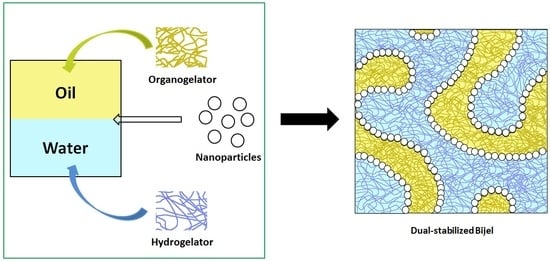Interfacial and Bulk Stabilization of Oil/Water System: A Novel Synergistic Approach
Abstract
:1. Introduction
2. Results and Discussion
3. Conclusions
4. Methods
4.1. Materials
4.2. Preparation of Different Oil/Water Systems
5. Characterization
Author Contributions
Funding
Acknowledgments
Conflicts of Interest
References
- Chevalier, Y.; Bolzinger, M.-A. Emulsions stabilized with solid nanoparticles: Pickering emulsions. Colloids Surf. A Physicochem. Eng. Asp. 2013, 439, 23–34. [Google Scholar] [CrossRef]
- Herzig, E.M.; White, K.A.; Schofield, A.B.; Poon, W.C.K.; Clegg, P.S. Bicontinuous emulsions stabilized solely by colloidal particles. Nat. Mater. 2007, 6, 966–971. [Google Scholar] [CrossRef] [PubMed] [Green Version]
- Stratford, K.; Adhikari, R.; Pagonabarraga, I.; Desplat, J.C.; Cates, M.E. Colloidal Jamming at Interfaces: A Route to Fluid-Bicontinuous Gels. Science 2005, 309, 2198. [Google Scholar] [CrossRef] [PubMed] [Green Version]
- Huang, C.; Forth, J.; Wang, W.; Hong, K.; Smith, G.S.; Helms, B.A.; Russell, T.P. Bicontinuous structured liquids with sub-micrometre domains using nanoparticle surfactants. Nat. Nanotechnol. 2017, 12, 1060–1063. [Google Scholar] [CrossRef] [Green Version]
- Cui, M.; Emrick, T.; Russell, T.P. Stabilizing Liquid Drops in Nonequilibrium Shapes by the Interfacial Jamming of Nanoparticles. Science 2013, 342, 460. [Google Scholar] [CrossRef]
- Tcholakova, S.; Denkov, N.D.; Lips, A. Comparison of solid particles, globular proteins and surfactants as emulsifiers. Phys. Chem. Chem. Phys. 2008, 10, 1608–1627. [Google Scholar] [CrossRef]
- Shakeel, A.; Farooq, U.; Iqbal, T.; Yasin, S.; Lupi, F.R.; Gabriele, D. Key characteristics and modelling of bigels systems: A review. Mater. Sci. Eng. C 2019, 97, 932–953. [Google Scholar] [CrossRef]
- Di Michele, L.; Fiocco, D.; Varrato, F.; Sastry, S.; Eiser, E.; Foffi, G. Aggregation dynamics, structure, and mechanical properties of bigels. Soft Matter 2014, 10, 3633–3648. [Google Scholar] [CrossRef]
- Singh, V.K.; Banerjee, I.; Agarwal, T.; Pramanik, K.; Bhattacharya, M.K.; Pal, K. Guar gum and sesame oil based novel bigels for controlled drug delivery. Colloids Surf. B Biointerfaces 2014, 123, 582–592. [Google Scholar] [CrossRef]
- Cates, M.E.; Clegg, P.S. Bijels: A new class of soft materials. Soft Matter 2008, 4, 2132–2138. [Google Scholar] [CrossRef]
- Lee, M.N.; Mohraz, A. Bicontinuous Macroporous Materials from Bijel Templates. Adv. Mater. 2010, 22, 4836–4841. [Google Scholar] [CrossRef] [PubMed]
- Tavacoli, J.W.; Thijssen, J.H.J.; Schofield, A.B.; Clegg, P.S. Novel, Robust, and Versatile Bijels of Nitromethane, Ethanediol, and Colloidal Silica: Capsules, Sub-Ten-Micrometer Domains, and Mechanical Properties. Adv. Funct. Mater. 2011, 21, 2020–2027. [Google Scholar] [CrossRef]
- Lee, M.N.; Thijssen, J.H.J.; Witt, J.A.; Clegg, P.S.; Mohraz, A. Making a Robust Interfacial Scaffold: Bijel Rheology and its Link to Processability. Adv. Funct. Mater. 2013, 23, 417–423. [Google Scholar] [CrossRef]
- Reeves, M.; Brown, A.T.; Schofield, A.B.; Cates, M.E.; Thijssen, J.H.J. Particle-size effects in the formation of bicontinuous Pickering emulsions. Phys. Rev. E 2015, 92, 032308. [Google Scholar] [CrossRef] [PubMed] [Green Version]
- Shakeel, A.; Lupi, F.R.; Gabriele, D.; Baldino, N.; De Cindio, B. Bigels: A unique class of materials for drug delivery applications. Soft Mater. 2018, 16, 77–93. [Google Scholar] [CrossRef]
- Patel, A.; Mankoč, B.; Sintang, M.B.; Lesaffer, A.; Dewettinck, K. Fumed silica-based organogels and ‘aqueous-organic’ bigels. Rsc Adv. 2015, 5, 9703–9708. [Google Scholar] [CrossRef] [Green Version]
- Lupi, F.; Gentile, L.; Gabriele, D.; Mazzulla, S.; Baldino, N.; De Cindio, B. Olive oil and hyperthermal water bigels for cosmetic uses. J. Colloid Interface Sci. 2015, 459, 70–78. [Google Scholar] [CrossRef]
- Singh, V.K.; Ramesh, S.; Pal, K.; Anis, A.; Pradhan, D.K.; Pramanik, K. Olive oil based novel thermo-reversible emulsion hydrogels for controlled delivery applications. J. Mater. Sci. Mater. Med. 2014, 25, 703–721. [Google Scholar] [CrossRef]
- Shakeel, A.; Mahmood, H.; Farooq, U.; Ullah, Z.; Yasin, S.; Iqbal, T.; Chassagne, C.; Moniruzzaman, M. Rheology of Pure Ionic Liquids and Their Complex Fluids: A Review. ACS Sustain. Chem. Eng. 2019, 7, 13586–13626. [Google Scholar] [CrossRef] [Green Version]
- Lupi, F.R.; Shakeel, A.; Greco, V.; Oliviero Rossi, C.; Baldino, N.; Gabriele, D. A rheological and microstructural characterisation of bigels for cosmetic and pharmaceutical uses. Mater. Sci. Eng. C 2016, 69, 358–365. [Google Scholar] [CrossRef]
- Athanassiou, C.G.; Kavallieratos, N.G.; Benelli, G.; Losic, D.; Rani, P.U.; Desneux, N. Nanoparticles for pest control: current status and future perspectives. J. Pest Sci. 2018, 91, 1–15. [Google Scholar] [CrossRef]



© 2020 by the authors. Licensee MDPI, Basel, Switzerland. This article is an open access article distributed under the terms and conditions of the Creative Commons Attribution (CC BY) license (http://creativecommons.org/licenses/by/4.0/).
Share and Cite
Shakeel, A.; Farooq, U.; Chassagne, C. Interfacial and Bulk Stabilization of Oil/Water System: A Novel Synergistic Approach. Nanomaterials 2020, 10, 356. https://doi.org/10.3390/nano10020356
Shakeel A, Farooq U, Chassagne C. Interfacial and Bulk Stabilization of Oil/Water System: A Novel Synergistic Approach. Nanomaterials. 2020; 10(2):356. https://doi.org/10.3390/nano10020356
Chicago/Turabian StyleShakeel, Ahmad, Ujala Farooq, and Claire Chassagne. 2020. "Interfacial and Bulk Stabilization of Oil/Water System: A Novel Synergistic Approach" Nanomaterials 10, no. 2: 356. https://doi.org/10.3390/nano10020356
APA StyleShakeel, A., Farooq, U., & Chassagne, C. (2020). Interfacial and Bulk Stabilization of Oil/Water System: A Novel Synergistic Approach. Nanomaterials, 10(2), 356. https://doi.org/10.3390/nano10020356





